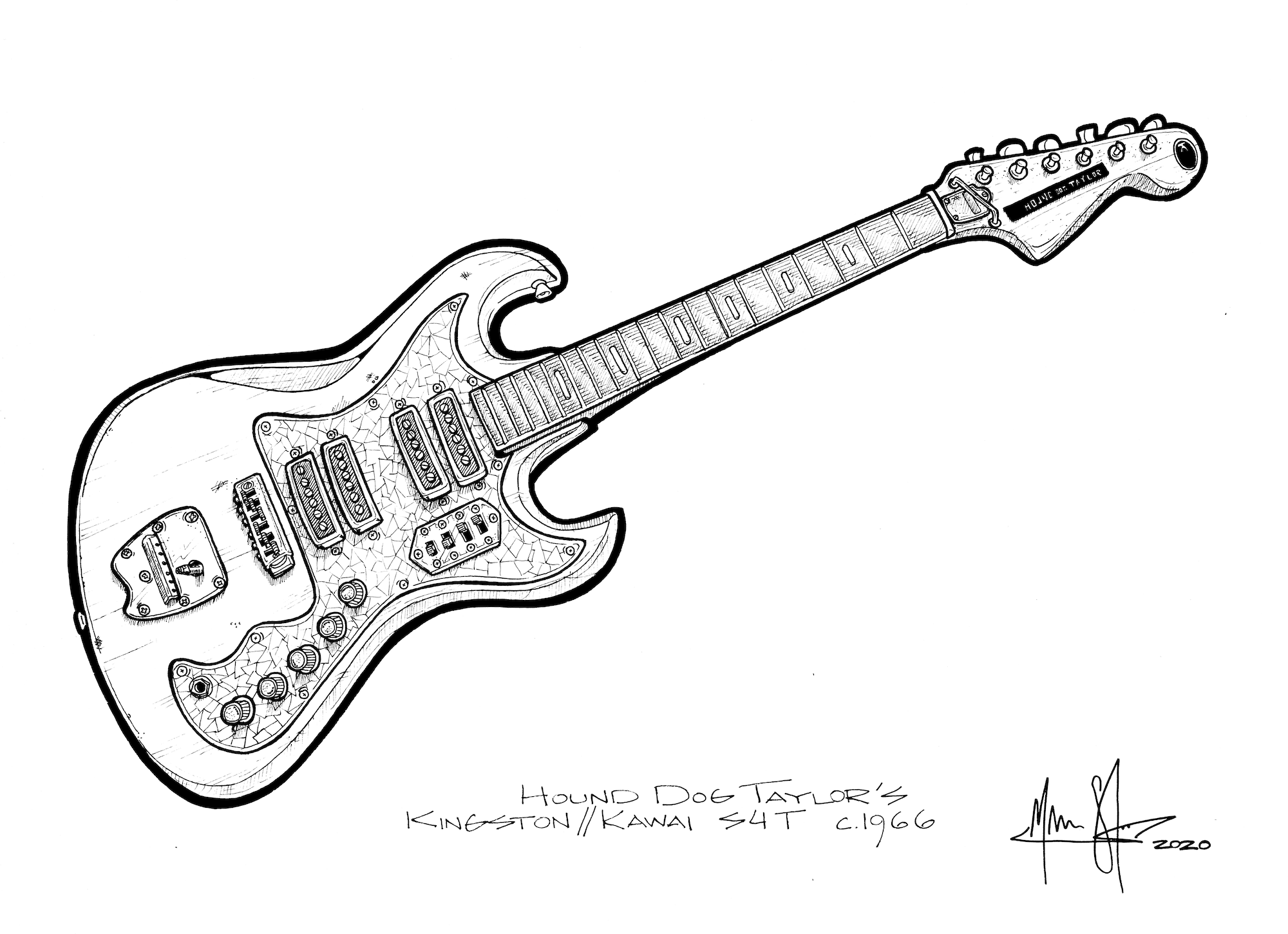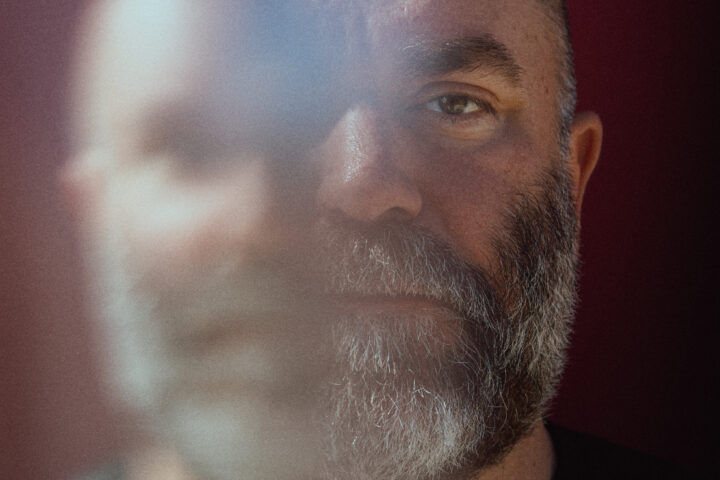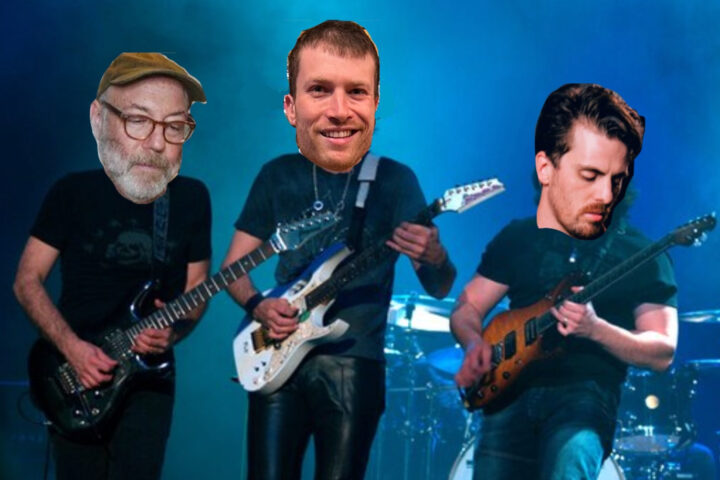At the time I called him during the fall of 2020, Mason Stoops—one of the most talented young guitarists in today’s Southern California music scene—should have been on the road backing up Jackson Browne. Instead, he was—like most of us riding out a pandemic—stuck at home.
But while many used COVID-19 downtime to perfect their bread baking or train a newly adopted puppy, Stoops stumbled upon the ultimate guitar-loving side hustle. Out of the Pasadena house he shares with fellow guitar phenom Harrison Whitford, Stoops was busier than ever, putting the finishing the touches on his latest pen and ink drawing. All summer long, he’s been at it: making and taking commissions from Instagram followers for guitar portraits, featuring gear both famous and not so famous. And as a pro player (and former art student), he catches details only fellow musicians would. We asked Stoops to talk a bit about his output and show off some of his favorite sketches. —JV
This started towards the end of April [2020]. I grew up loving drawing. The high school I originally went to, I auditioned and got into there, for visual art. This is just before I picked up guitar. In the 7th and 8th grade, my world was just drawing. It’s just always a thing that I loved to do.
I was in a visual arts program there for a couple years, but just hated it. They wanted me to draw fruit, hands, and shadows, and make clay candle holders and stuff like that. I wanted to draw cartoons and do something totally different. So I lost interest in that world and haven’t really dabbled in it since, and never thought of it as being something I can make money from.
Even when I started this, the idea wasn’t to make money. It was truly just something to do to keep sane during quarantine. I truly was running out of things to do. My relationship with music and guitar at that point was so up in the air, and I really didn’t know what I wanted to do…anything to distract.
I’d always had this Gumby icon. It was this pin from the early ’80s, of him holding a weird, kind of PRS-looking guitar. I had always thought it’d be cool if he was holding a Tele. It’d be even cooler if I could draw him doing my Tele, but never made the time. But here we are in, you know, quarantine.
[My girlfriend] is a graphic designer at her firm and an amazing painter and artist on her own. She’s good at Photoshop in ways that I’m not. So I was like, If I draw my guitar, could you help me put it into this Gumby logo? She didn’t really understand why I wanted to do this. But I did that and put it on Instagram. This is what I did this week. In the post, I had shown that it was just a drawing of the guitar at one point. And someone messaged me on Instagram the next day, asking, “Hey, could you draw my guitar?”
I said, “Yeah, I guess.” It was one of the Albert Lee super-pointy Music Man guitars. That was the first one. I posted that the next day, and then a couple more people reached out: Could you draw our guitars? Each time I did one, I would post it, and more people would reach out. It got to a point where I thought, “I guess I should charge?” My girlfriend was like, “Yeah, you can’t just sit at home and draw guitars all day for free.” But I totally could have—there are no gigs, there are no sessions.
I was just in this crazy guitar and music depression of not knowing if I wanted to still play guitar. If I never played another note, would it matter, would anyone care? Just getting really heavy on guitars. To suddenly have this outlet that still allowed me to be super detail-oriented and look at pictures of guitars all day…that’s all I wanted to do. It just grew from there. I would feature a different guitar each day, because I could knock out one or two drawings a day. I’d post about the artist that had asked for the drawing and what music they played. That’s where it all began.
With each one I did, I would learn something, a little bit about drawing. And it was really easy to set goals. It’s not easy to set goals playing the guitar, because it’s so amorphous, it’s this moving target of what do I want to work on, or learn or practice? But with drawings, you could finish one and look at it and go, “Okay, next time I really have to get better at knobs, ’cause these are shitty-looking knobs.”
It was just easy to take something to develop. At first, it would take me an hour and a half to do one, maybe two hours at most if it were a bigger piece of paper. I was doing them on printer paper at first, just using Sharpies or what was around. Then it was like, okay, I should get some better pens and maybe better paper. It got to a point where I was getting about 10 commissions a day, which is crazy. And then, suddenly, it was steady income. Now I plan on doing three or four a day.
It gave me a work schedule. For the first time since I got fired from Guitar Center when was 17, I was making money not from being a guitar player—and figuring out how to do something besides play guitar. It took all this pressure off that was always there with guitar: Bills are coming up, it’s competitive, you have to keep getting better. It’s not a toxic relationship, but [it’s] a high-pressure relationship. I need money and I need gigs. And if the phone’s not ringing, you’re very stressed.
So now, in the midst of feeling really unsure about guitar and what I wanted to do or where I wanted to go with it, I had this other outlet fall into my lap that took all the pressure off for the first time. It allowed me to look at guitar without being scared of when I was going to get paid this month or whether I was growing. It was fun again for the first time in a while.
This whole process grew. I started asking people to send me music that they had recorded with the guitars that they were asking me to draw. I’d wake up in the morning, I’d make coffee and I’d sit at my desk. I would put on the Truth About Vintage Amps podcast or Reply All and I would just sit there and just draw all day. It’s the closest I’ve had to a day job where I just sat in one place and did something.
I switched over from podcasts to asking people to send me albums that they were listening to, or send me recordings of the guitar that I was drawing. It forced me to listen to new music and not listen to guitar from a career perspective, where I’m constantly listening to what chords or who’s playing what. I was just getting and enjoying music while being in my own world and drawing, trying to draw knobs slightly better.
I really want to be accurate. And I really want to be authentic to each guitar. These people love their guitars. It’s like their pet; they know every little detail, every ding and scratch and mark. They remember the gig where they dropped the guitar onstage and that’s where that ding came from. And so when you’re drawing these guitars, like, I want to capture all those details.
It’s been so frustrating as a guitar player. Any time you see a guitar being drawn in a painting or a picture, they’re always so shitty. They’re weird and asymmetrical and they have random numbers of knobs and tuning pegs and strings. You never see really accurate portrayals of guitars. And I love details. Trying to match all those details and get everyone’s to where they—when they look at it, their eyes light up. “That’s my guitar.” Especially since it’s just a Tele or a Strat. It’s really hard to distinguish.
Then you get in a position of how do you actually draw tortoiseshell, especially in black and white, since I’m only doing this with ink and paper. I just have a bunch of Micron pens. So learning how to get Sunbursts… that shade with only black and white.
I started this H-22/1 Harmony bass for Bob Glaub. It’s going to take me the rest of the afternoon and probably early evening to finish it. They’ve gotten so much more detailed. It’s cool to have trackable progress versus practicing and learning guitar.
And you never really know—Am I getting better? Am I growing, am I learning anything? It’s so hard to reflect. Sometimes, I’ll see a demo video from 10 years ago of me playing guitar. I played that same riff last week in a session. Have I grown at all, am I really better? It’s such a head game, all the time.
But with drawings, you have to look. I was this good this month, and then with each drawing and each day, just getting a little bit better. So, I’m excited. It feels good to be able to look back on quarantine and all of this and have something that I feel like I actually invested in and got better at. That indirectly helped me fall back in love with guitar and made me want to pick up the guitar in a new way. It’s been really positive.
This article appeared in the Fretboard Journal #47 with additional illustrations.



